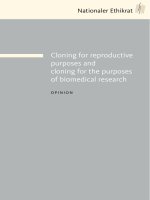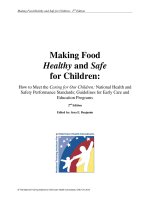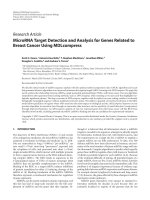Continuing Challenges and Potential for Collaborative Approaches to Education Reform pot
Bạn đang xem bản rút gọn của tài liệu. Xem và tải ngay bản đầy đủ của tài liệu tại đây (569.64 KB, 125 trang )
For More Information
Visit RAND at www.rand.org
Explore RAND Education
View document details
Support RAND
Purchase this document
Browse Reports & Bookstore
Make a charitable contribution
Limited Electronic Distribution Rights
is document and trademark(s) contained herein are protected by law as indicated
in a notice appearing later in this work. is electronic representation of RAND
intellectual property is provided for non-commercial use only. Unauthorized posting
of RAND electronic documents to a non-RAND website is prohibited. RAND
electronic documents are protected under copyright law. Permission is required
from RAND to reproduce, or reuse in another form, any of our research documents
for commercial use. For information on reprint and linking permissions, please see
RAND Permissions.
Skip all front matter: Jump to Page 16
e RAND Corporation is a nonprot institution that
helps improve policy and decisionmaking through
research and analysis.
is electronic document was made available from
www.rand.org as a public service of the RAND
Corporation.
CHILDREN AND FAMILIES
EDUCATION AND THE ARTS
ENERGY AND ENVIRONMENT
HEALTH AND HEALTH CARE
INFRASTRUCTURE AND
TRANSPORTATION
INTERNATIONAL AFFAIRS
LAW AND BUSINESS
NATIONAL SECURITY
POPULATION AND AGING
PUBLIC SAFETY
SCIENCE AND TECHNOLOGY
TERRORISM AND
HOMELAND SECURITY
This product is part of the RAND Corporation monograph series.
RAND monographs present major research findings that address the
challenges facing the public and private sectors. All RAND mono-
graphs undergo rigorous peer review to ensure high standards for
research quality and objectivity.
Susan J. Bodilly, Rita Karam, Nate Orr
Sponsored by the Ford Foundation
EDUCATION
Continuing Challenges
and Potential for
Collaborative
Approaches to
Education Reform
The RAND Corporation is a nonprofit institution that helps improve
policy and decisionmaking through research and analysis. RAND’s
publications do not necessarily reflect the opinions of its research clients
and sponsors.
R
®
is a registered trademark.
© Copyright 2011 RAND Corporation
Permission is given to duplicate this document for personal use only, as
long as it is unaltered and complete. Copies may not be duplicated for
commercial purposes. Unauthorized posting of RAND documents to a
non-RAND website is prohibited. RAND documents are protected under
copyright law. For information on reprint and linking permissions, please
visit the RAND permissions page ( />permissions.html).
Published 2011 by the RAND Corporation
1776 Main Street, P.O. Box 2138, Santa Monica, CA 90407-2138
1200 South Hayes Street, Arlington, VA 22202-5050
4570 Fifth Avenue, Suite 600, Pittsburgh, PA 15213-2665
RAND URL:
To order RAND documents or to obtain additional information, contact
Distribution Services: Telephone: (310) 451-7002;
Fax: (310) 451-6915; Email:
Library of Congress Cataloging-in-Publication Data is available for this publication.
ISBN 978-0-8330-5152-3
Cover illustration courtesy Getty Images
The research in this report was produced within RAND Education,
a unit of the RAND Corporation. The research was sponsored by the
Ford Foundation.
iii
Preface
In 1997, the Ford Foundation began an eort, called the Collaborating
for Education Reform Initiative (CERI), to promote school improve-
ment in communities. It funded eight sites to establish collaboratives of
community-based organizations and local school districts that were to
create and sustain education reforms in their local areas. As part of this
eort, the foundation sponsored a formative assessment of the grant-
ees’ progress, to be carried out by the RAND Corporation from 1999
to 2003. e assessment was documented in Challenges and Potential
of a Collaborative Approach to Education Reform (Bodilly, Chun, et al.,
2004).
In 2004, the foundation dropped ve sites and added two new
sites to the initiative. RAND continued to track the progress made
toward the grantees’ goals from 2004 to 2009. is monograph docu-
ments the progress made by the grantees during that time period.
e audiences for this monograph are policymakers involved in
trying to build sustained support for educational improvement and
practitioners interested in using collaborative eorts among commu-
nity organizations to improve public educational services.
is research was conducted by RAND Education, a unit of the
RAND Corporation.
v
Contents
Preface iii
Tables
ix
Summary
xi
Acknowledgments
xix
Abbreviations
xxi
CHAPTER ONE
Introduction 1
Background on the Initiative
1
e History of CERI 1 (1998–2003)
2
e History of CERI 2 (2004–2009)
3
Purpose and Approach
6
Remainder of the Monograph
8
CHAPTER TWO
Approach, Concepts, and Development of Indicators 11
Approach
11
Data Sources
13
Documents
13
Yearly Site Visits with Interviews, Focus Groups, and Informal
Observations
13
e Urban Partnership Program and CERI 1 Phone Survey
15
Administrative Data
15
Analysis
16
Study Limitations
17
Literature Review
17
vi Continuing Challenges and Potential for Collaborative Approaches
Interorganizational Linkages 17
Expectations for Implementation
19
Implications
20
Indicators of Progress
22
CHAPTER THREE
Progress Toward Collaborative Functioning and Sustainment 25
Overview of Progress Toward Collaborative Function and
Sustainment
25
e Alianza, Puerto Rico
29
Ask for More, Jackson, Mississippi
32
Austin Interfaith, Austin, Texas
35
DC VOICE, District of Columbia
38
Grow Your Own, Chicago, Illinois
40
Urban Partnership Program and Former Collaborating for Education
Reform Initiative 1 Sites
44
Summary of Progress Made, Enablers, and Constraints
45
Collaborative Eorts Are Highly Susceptible to Constraints and
Changes in the Environment
46
Leadership Change Aected Collaborative Growth
48
Inclusiveness in Leadership Plays an Important Role in Collaborative
Building and Growth
49
Building the Legitimacy of the Collaborative Proved Critical for
Growth and Sustainment
50
Information Developing and Sharing and Joint Decisionmaking
Supported Collaborative Function
51
Conicts Among Partners Aected Some Eorts
51
Fundraising Needed to Be Attended to Early
52
CHAPTER FOUR
Progress Toward Goals 55
Summary of Activities Undertaken
55
Were Choices Reasonable?
58
Summary of Progress Toward Goals
65
e Alianza
68
Promote Quality in Teaching and Learning
69
Contents vii
Promote Policies at Lead to Quality in Teaching and Learning 69
Ask for More
70
Promote Quality in Teaching and Learning
71
Promote Policies at Lead to Quality in Teaching and Learning
74
Become a Voice for Collaboration
75
Austin Interfaith
75
Promote Quality in Teaching and Learning
75
Promote Policies at Lead to Quality in Teaching and Learning
76
Become a Voice in the Community
80
DC VOICE
80
Promote Policies at Lead to Quality in Teaching and Learning
81
Become a Voice for the Community
83
Grow Your Own
83
Promote Policies at Lead to Quality in Teaching and Learning
84
Cross-Site emes on the Implementation of Activities
86
e Criteria Used for Choosing an Intervention Played a Large
Role in Its Success
87
Regular Needs Assessment and Reection Enabled Benecial
Adaptation of Interventions
88
Use of Collaborative Approaches to Implementation Facilitated
Progress
88
Collaboratives Faced Challenges in Implementing Activities with
Dwindling Foundation Support
89
Intervention Implementation Was Aected by the Political and
Economic Context
90
CHAPTER FIVE
Conclusions and Observations 91
Findings and Conclusions
91
Building and Sustaining Collaboratives
92
Promoting Quality in Teaching and Learning
93
Developing a Voice for Reform
94
Emerging Lessons for Foundation Eorts
95
References
99
ix
Tables
1.1. Collaboratives’ Original Descriptions, 2003–2005 Plans 7
1.2. CERI 2 Sites Started with Signicant Variation
8
2.1. Number of Interviewees
13
3.1. Sites’ Progress Toward Attaining and Growing
Collaboration (2009)
27
4.1. Proposed Activities to Address Collaborating for Education
Reform Initiative 2 Goals
57
4.2. Reasonableness of Goals and Activities
59
4.3. Level of Implementation of Activities by Sites
66
xi
Summary
Introduction
After years of grant making, Ford Foundation sta strongly believed
that a school district central oce could not reform itself; rather, they
believed that reform could be promoted by relying on collaborations
among organizations outside the district central oce to sustain reform.
is belief grew out of other foundations’ experiences with collabora-
tive eorts and the Ford Foundation’s own previous eorts at collabor-
ative formation from 1991 to 2000 in the Urban Partnership Program
(UPP). us, the foundation wanted to promote an education reform
strategy based on local collaboration among community organizations.
Based on these premises, the foundation began a new initiative
in 1997–1998—the Collaborating for Education Reform Initiative
(CERI)—by issuing grants to organizations in eight communities and
providing the sites with funds, guidance, and technical assistance to
develop collaboratives and carry out activities to improve teaching and
learning. CERI’s collaborative activities were directed at three possible
community groups: the district, a feeder pattern or cluster of schools in
a district, and the larger community, such as parents and voters.
In 1999, the foundation asked the RAND Corporation to for-
matively assess CERI to provide sites with feedback to improve their
eorts, provide information to inform the foundation’s decisions about
support and funding to grantees, and document the challenges and
possible successes of this approach to school improvement. During this
period, RAND tracked the sites’ progress toward CERI’s goals and
xii Continuing Challenges and Potential for Collaborative Approaches
reported on the rst ve years of the eort in 2004 (Bodilly, Chun,
etal., 2004).
In 2004, the foundation reorganized CERI by dropping ve of
the original eight grantees and adding two new ones (for a total of ve):
• the Alianza Metropolitana de San Juan Para La Educación in San
Juan, Puerto Rico. is collaborative of several community-based
organizations (CBOs) and a major university sought to promote
student achievement by scaling up a school improvement model
developed under CERI 1 and demonstrated in Catano, Puerto Rico,
and by creating the rst education policy institute on the island.
• Ask for More (AFM) in Jackson, Mississippi. is new collabora-
tive was created in response to CERI 1 and led by a CBO called
Parents for Public Schools (PPS) that chose to promote student
achievement by developing and demonstrating best practices in a
specic feeder pattern and then scaling these up to the district.
• Austin Interfaith (AI) in Austin, Texas. is CBO with ties
to church congregations is dedicated to improving the lives of
underserved minorities and proposed work with other CBOs to
build a teacher pipeline to provide high-quality teachers to hard-to-
sta schools.
• DC VOICE in Washington, D.C. is private, nonprot orga-
nization was created during CERI 1 with the goal of providing
research-based advocacy for improving the supports oered in the dis-
trict for improved teacher quality.
• Grow Your Own (GYO) in Chicago, Illinois. is combination
of CBOs led by the Association of Community Organizations for
Reform Now (ACORN) proposed to develop a pipeline of high-
quality teachers for hard-to-sta schools.
is new incarnation of CERI went forward with these ve grant-
ees until 2009. With the restructuring, the foundation emphasized col-
laborative activities designed to aect district and state education poli-
cies but, unlike in CERI 1, oered very little technical assistance to
the sites. e foundation expected the collaborative activities to result
in changes in teaching and learning in the schools in the local school
Summary xiii
districts. Specically, the foundation had laid down a new set of goals
for the ve sites:
• Develop interorganizational linkages to the point of becom-
ing a well-functioning collaborative and achieve nancial
independence.
• Develop and implement plans for improving the quality of teach-
ing and learning.
• Develop and implement plans for systemic changes in policy to
support improved teaching and learning.
• Develop a unique voice for underserved communities outside of
the central oce to air concerns about educational services.
Our Research Purpose and Approach
In 2004, the foundation asked RAND to track the sites’ progress
toward CERI’s new goals and provide feedback to the foundation and
the ve grantees, documenting any lessons that others might learn
from this eort. e research questions addressed from 2004 to 2009
were as follows:
1. Did grantees show progress toward desired outcomes?
a. Did they develop collaborative interorganizational linkages
and nd sustainable funding?
b. Did they choose reasonable interventions that might be
expected to have impact?
c. Did they make progress in promoting teaching and learn-
ing, in promoting policy initiatives, and in acting as a “voice
in the community”?
2. What lessons or promising practices resulted from the experi-
ences of individual collaboratives or the group as a whole?
3. Did the foundation create nancially sustainable collabora-
tives that can promote education improvement?
xiv Continuing Challenges and Potential for Collaborative Approaches
To help answer these research questions, we chose a replicated
case-study approach, viewing each collaborative and its surrounding
community as a single embedded case. We collected and analyzed data
from multiple sources—including extensive eld interviews; docu-
ments, such as newspaper articles and printed materials provided by
collaborative members; and limited administrative data supplied by
districts and schools. ese data were organized thematically in rela-
tion to the research questions and synthesized to identify common and
contrasting themes across the sites.
Findings
Here, we present the key ndings in relation to the three research
questions.
Research Question 1: Did Grantees Show Progress Toward Desired
Outcomes?
Overall, we found that the second CERI eort (CERI2) resulted in
several functioning collaboratives but that those collaboratives’ ability
to meet their goals varied widely, something that emerges when we
look more specically at the three suboutcomes.
Did They Develop Collaborative Interorganizational Linkages
and Find Sustainable Funding? At the end of the study in 2009, AI
appeared to be largely self-sustaining and growing in terms of linking
up to new groups to positively inuence policy at the state and local
levels in Texas and in terms of taking on new initiatives. Because of
a very dicult state environment for nonprots and an inability to
gain traction in a very rapidly changing environment, the Alianza was
functioning as a “network of CBOs” interested in reform rather than
as a collaborative. e other three sites appeared to be in a state of
“reection and planning,” having accomplished some goals but being
in the process of deciding “where to go from here.” Chicago’s GYO and
Washington’s DC VOICE had some ability to sustain themselves, and
each was actively pursuing an agenda with partners. e Jackson AFM
Summary xv
collaborative could not be sustained without external funding and had
not identied such sources successfully.
Did They Choose Reasonable Interventions That Might Be
Expected to Have Impact? e sites had diculty choosing appropri-
ate interventions that showed promise in having an impact on student
performance and in being able to be scaled up. Although all ve sites
appropriately identied the needs of the schools in their communi-
ties, the interventions they selected to address the problems were often
not clearly connected to a research literature showing proven results.
Furthermore, many of the interventions, such as the development and
implementation of a teacher pipeline targeting school and community
members in poor inner-city areas, required resources and time beyond
the period of the foundation grant to fully implement and show empir-
ical results, which posed signicant challenges, especially when they
were asked to become self-sustaining in the recessionary market of
2008–2009.
Did They Make Progress in Promoting Teaching and Learning,
in Promoting Policy Initiatives, and in Acting as a “Voice in the Com-
munity”? In terms of making progress toward promoting teaching and
learning, only three of the sites—AI, the Alianza, and AFM—chose
interventions that were somewhat designed to have a direct impact
on teaching and learning. Usually, these interventions included pro-
fessional development for leaders, teachers, counselors, and parents.
One exception was AI’s eort to create a cluster of district schools,
with greater exibility and autonomy than other schools in the dis-
trict. e sites also varied in their ability to implement their chosen
interventions, and those interventions’ impact on teaching and learn-
ing also varied by site. By 2007, the Alianza stopped providing profes-
sional development to its districts, and respondents there noted that
the Alianza’s long-term impact was insignicant. AI’s eorts to create
an independent cluster of schools failed to be approved, but AFM was
able to promote principal collaboration and articulate greater vertical
alignment of district curriculum.
All the sites attempted to aect state or local policies to support
quality teaching and learning. Two of the grantees—AI and AFM—
showed signicant progress in this area, especially in terms of chang-
xvi Continuing Challenges and Potential for Collaborative Approaches
ing school behaviors. Working with others (e.g., sister organizations,
teacher unions, churches), AI inuenced the state legislature to pass
a bill that limited the percentage of time that schools were allowed
to spend on testing students, thus directly aecting teacher behav-
ior. Interventions implemented by AFM in a high school feeder pat-
tern known as the Lanier cluster were adopted by the school district.
Another intervention in AFM involved principal-to-principal collabo-
ration within a feed pattern, which produced changes in how school
leaders collaborated and shared information.
GYO ran a grassroots organizing campaign, successfully ensur-
ing the passage of an Illinois initiative to develop and implement a
teacher pipeline. However, this policy’s eectiveness at improving stu-
dent outcomes depended on many factors, including the retention rate
of teacher candidates and the length of time to their graduation and
placement in Chicago schools. At the time of our last visit, in 2009,
the teacher pipeline’s impact on teaching and learning was not promis-
ing. None of the GYO candidates had graduated and started teaching
in Chicago public schools. In fact, many were still taking classes at the
community college level.
DC VOICE’s eorts to aect policy diminished over time because
of the mayoral takeover of the District of Columbia Public Schools
(DCPS) in 2007. Finally, the Alianza had not established a viable, well-
functioning policy institute, which was a major goal of its grant.
When we look at the collaboratives becoming a voice for the
underserved and underrepresented, only AI became a strong voice in
education reform at both the local and state levels through its part-
nership with other strong organizations and community mobiliz-
ing eorts. Two other sites made progress, but on a lesser scale. DC
VOICE developed and engaged leaders from underserved populations
in educational issues through mobilizing activities within the District
of Columbia. AFM became the voice of the community on specic
issues pertaining to collaborative approaches.
Summary xvii
Research Question 2: What Lessons or Promising Practices Resulted
from the Experiences of Individual Collaboratives or the Group as a
Whole?
Looking across the sites, we identied several themes pertaining to
building and sustaining collaboratives; promoting quality teaching,
learning, and policy initiatives; and developing the voice of reform.
e study found that the sites’ abilities to develop and sustain
strong collaboratives were facilitated by several factors, including strong
leadership that could promote shared goals among the members, a pos-
itive funding environment, and the ability to produce information,
funding, and progress that were valuable to members and stakehold-
ers. Several factors hindered collaborative development and sustain-
ment, the most crucial of which was a severe change in the nancial
environment.
Furthermore, collaboratives that were able to inuence teaching
and learning or educational policies were those that had amiable rela-
tionships with the central oce or strong stakeholder support (or both).
Other factors identied as critical for promoting teaching and learning
include the adoption of “reasonable” interventions that were proven to
be eective and aligned with identied educational goals and contex-
tual needs, selection of interventions aligned with collaborative exper-
tise, continuous monitoring of the performance of interventions, and
the use of collaborative approaches for implementing interventions.
Regarding the development of constituency voice, factors the
study identied as important include collaboratives’ consistency of
and adherence to their mission over time to increase public condence
in their work, and collaboratives’ involvement of a broad segment of
the community that has legitimacy and power in the education policy
arena.
Research Question 3: Did the Foundation Create Financially
Sustainable Collaboratives That Can Promote Education
Improvement?
In answer to the last research question, we conclude that collaboratives
can be deliberately formed with support by outside funders, such as
the Ford Foundation. However, it is not a straightforward process, and
xviii Continuing Challenges and Potential for Collaborative Approaches
the nancial sustainability of the grantees’ initiatives remained highly
uncertain in the recessionary environment.
Lessons from this eort point to actions that foundations and col-
laboratives might take to ensure a more-successful eort, especially in
uncertain environments. Specically, we suggest that future eorts at
collaborative formation promote the following actions:
• More-clearly communicate expectations at the start of the ini-
tiative and more-carefully consider the alignment between goals,
interventions, available resources, and the time frame of the
initiative.
• Make use of data to diagnose problems, conduct strategic plan-
ning, develop activities, and provide feedback, especially during
the planning stages.
• Conduct more-routine and regular meetings and promote data
sharing across sites aimed at providing opportunities to learn
about progress in general and comparative progress.
• Pay attention early on to future fundraising by the collaboratives,
and provide foundation supports for these eorts.
• Foster the development of a foundation collaborative process and
the adoption of such processes by collaborative leaders.
Adopting these suggestions cannot guarantee strong progress, but
doing so might enable stronger collaborative formation.
xix
Acknowledgments
We wish to thank the many people who contributed to this work.
e Ford Foundation program ocers were a major source of
inspiration and insight during this project. Janice Petrovich and Cyrus
Driver from the foundation, in particular, provided guidance and
support.
e project could not have been completed without the signi-
cant help of the members of each of the collaboratives studied, espe-
cially their leaders. In addition, schools involved with the collaboratives
opened their doors to us to help study the impact of implemented activ-
ities. Districts provided us with signicant support in terms of data and
time. We thank all of them for their support and contributions.
e monograph continues the work summarized in a previous
report (Bodilly, Chun, et al., 2004). Some basic methodological mate-
rial and synopsis of the initial years of the initiative are taken from that
document, and we wish to thank the authors for their contributions to
the groundwork of this second study.
Several members of the RAND sta contributed greatly to the
work contained within this monograph, including Dahlia Lichter
and Alice Taylor. Much of this monograph’s value rests on their
contributions.
Reviewers played an important role throughout this project. ese
included Amanda Datnow of the University of California, San Diego;
Julie Marsh of the University of Southern California; and Cathy Stasz
of RAND. We thank them for their insights and eorts to make our
xx Continuing Challenges and Potential for Collaborative Approaches
work better. Although they helped improve the monograph, the nal
contents are the responsibility solely of the authors.
xxi
Abbreviations
ACORN Association of Community Organizations for Reform
Now
AFM Ask for More
AI Austin Interfaith
AISD Austin Independent School District
CBO community-based organization
CCC Cross City Campaign for Urban School Reform
CERI Collaborating for Education Reform Initiative
CPS Chicago Public Schools
DCPS District of Columbia Public Schools
DECCES Demonstrative District for the Systemic Change in
Education
DFC Design for Change
FRL free and reduced-price lunch
FY scal year
GYO Grow Your Own
IPEDCo Institute of Educational Policy for Community
Development
xxii Continuing Challenges and Potential for Collaborative Approaches
ISBE Illinois State Board of Education
JPS Jackson Public Schools
LCN Learning Communities Network
LEP limited English prociency
LSNA Logan Square Neighborhood Association
LVCDC Little Village Community Development Corporation
MOU memorandum of understanding
PEN Public Education Network
PLI Parent Leadership Institute
PPS Parents for Public Schools
PRCF Puerto Rico Community Foundation
PTA parent-teacher association
RFP request for proposals
SQT Supports for Quality Teaching
UPP Urban Partnership Program
1
CHAPTER ONE
Introduction
e Ford Foundation, frustrated with past attempts at encouraging
the improvement of educational services in U.S. inner cities, began
an initiative it hoped would bring about more-sustained change. e
foundation called its eort the Collaborating for Education Reform
Initiative (CERI). From 1997 through 2003, it funded eight collabora-
tive eorts in selected cities in the hope of developing and sustaining
educational improvement. In 2004, it restructured CERI to support
ve collaborative eorts and began what it referred to as CERI 2.
e remainder of this chapter provides the reader with the foun-
dation’s rationale for the original CERI and the following CERI 2, the
role RAND played, and the purpose of the research and the general
approach RAND took to examine CERI 2. Finally, it outlines the rest
of this monograph.
Background on the Initiative
e Ford Foundation advanced a vision of education reform to improve
the educational achievement of a large number of students and promote
system-wide changes in policies and practices. e intent of CERI was
specically to improve the quality of teaching and learning in classrooms
and schools in fundamental ways in order to increase student outcomes.
CERI diered from many other education reform initiatives in
two ways. First, the foundation believed that central district oces
lacked the ability to improve teaching and learning because central
district oces









